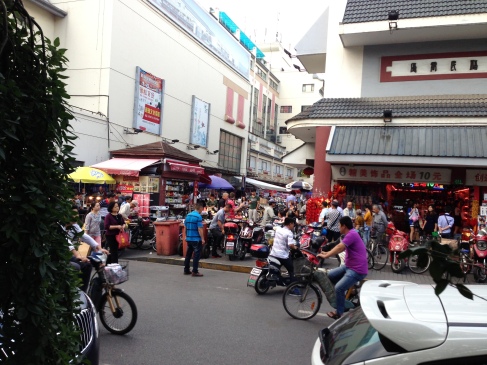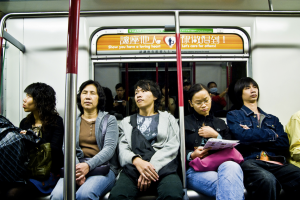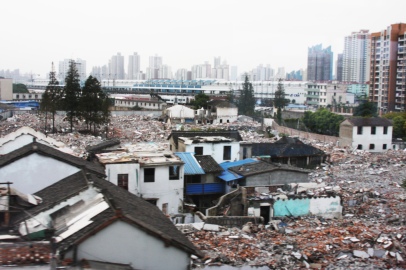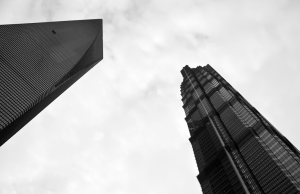
I must admit that coming to China I had formed some preconceptions, though unfounded, they still made their way into my mind. The most prominent and most embarrassingly stereotypical was luckily the first to be challenged, almost immediately, through my Shanghai experiences. The notion centered on the idea of control. China due to its communist past, and the still centralized government’s reputation, I imagined the population to appear slightly repressed upon arrival. My first journey into the city dismantled this view and replaced it with the opposite impression. The lack of control is most striking; the urban citizen is allowed to operate with a high level of autonomy, using the street as a truly public realm. From street vendors clustering around subway exits to temporal wet markets, the Chinese street has led me to question what constitutes freedom within the urban realm.
The level of public access that the Chinese urbanites have in the utilization of their streetscape is amplified by the juxtaposition of my past experiences. The United States, of course, is the counter pole of this activity but even the Japanese street wanes in comparison to the activity of China. The key difference between China and the other two nations seems intrinsically tied to levels of development. As a nation develops the occurrences that have made China so immensely interesting on this trip tend to disappear, the street becomes regulated, excluding uncontrolled activities. This trajectory of development seems to allude to a contradictory process: that as the city modernizes, moves toward a service economy, it becomes less free. Its inhabitants become more restricted, choice is diminished, regulation is imposed and enforced. Yet if one continues to compare and contrast say a city like Shanghai and Tokyo, it becomes apparent that freedom does not have a singular definition within the city but is something much more complex.
In Tokyo the population has given up a large amount of individual freedom and expression for the freedom of the larger whole. The immense conformity of the population, has allowed for an amazingly efficient, economically driven society to develop. But with the sacrifice in self-expression comes many benefits; most people can afford the consumerist lifestyle that drives society. Additionally the city is made democratic by the clockwork efficiency of its transportation system, creating a physically accessible city.
China’s current urban freedom, amplifies the opportunities of the individual. As a result of rapid urbanization the population must be given a large level of autonomy else the city would cease to function. The wealth distribution is too unequal to force the entire population to attain their goods and services from large, commercialized, global brands. The question now is how will freedom be defined as the Chinese city continues to develop. Given the statements of Third Plenary Session of the 18th Central Committee concerning “human-centered-urbanization” and a “rebalancing of the economy,” the future is somewhat uncertain. Though human-centered-urbanization sounds as though it should support the microeconomic activity of the individual the rebalancing of the economy focuses on the need for the population to become more consumerist centric; therefore it could be argued that the Chinese government’s definition of freedom is that to consume. Yet it is more than just general consumption, for that occurs already , microeconomic activities are of course tied to consumptive needs, yet I believe consumptive centric development focuses of the creation of consumptive desires rather than only needs.
Filed under: Desensitize, development, Freedom, individuality, pedestrians, public space, Street











October 31, 2010 • 8:49 am 0
Going Astray for…
Beijing’s 798 is one of China’s contemporary art districts supported by a broad range of art galleries, cafés, artist studios, bookstores, and shops. Before entering 798, I considered the irony of Beijing, being the capital of Communist China and control center of censorship, allowing social commentary charged art to be displayed. Upon entering the first gallery, every piece of art had commentary on Chinese culture, past and present. I continued through 798, and immediately stopping the Cuba Avant-Garde art show. After seeing waves of galleries displaying Chinese artists, why was it that Cuban art was able to make it to 798?
I wandered into the Xin Dong Cheng art space seeing a various display of Cuban art, understanding that most pieces had a social commentary on the Cuban socialist government. I was drawn to Rene Francisco Rodriguez pieces because of its simplicity, but its high attention to detail.
This first piece displays a monochrome composition of people forming the Cuba with a stray figure wandering off to the right corner. Upon looking closer at the drawing, everything was composed of Q-tip sized dots for each person’s head, body, and legs. Rather than painting the background gray and dotting the people in, the artist painstakingly dotted every square centimeter of the canvas, making it impossible to ignore his intention for doing so.
The dotted paint seemed to represent the idea of socialism and everyone being equal. From far away, the picture appeared as a nicely shaded island of Cuba, indicating the country as a whole unified piece. Looking closely, the human figures appear to illustrate that Cuba is composed of individuals for the same good of socialism. However, what about the Stray veering off to the right?
Socialism on paper seems like a viable political concept. But in reality, not everyone is content with its agenda and outcome. Equality is great, but how much do you have to give up in order for everyone to be at the same level? How much are people willing to sacrifice for the common good? The stray figure symbolized the individuals who weren’t able accept the socialist Cuba and left for another life, deeming themselves as outcasts of the whole picture of Cuba. Perhaps the author sees himself as this single person, using art as a way to display his feelings towards Cuba’s communist regime.
From this analysis, I started to draw connections to China. The most obvious similarity is their communist government. Both countries underwent a transformation that affected the overall lifestyle of their citizens and many fled to other countries to pursue a better life. However, since then, China has had a different interpretation of Socialism than Cuba and has yielded extreme development results. Cuba’s growth has not evolved to that of China’s and perhaps gives many individuals like the artist frustration that the whole country can’t seem to progress further. It may have also been the intention of the curator to show very subtly the uncertainty and perhaps negative aspects of communism through the Cuban lens.
Looking at China’s fast pace of development, there is a mix between Communism and Capitalism. Few would say that China is completely socialist, but many policies like the lack of land ownership still remind people of its overarching communist stance. In America, we pride ourselves for having freedom of speech and press, but when these rights are challenged, there is a notion that people don’t necessarily have the liberty to express their opinions. We also pride ourselves on democracy, which is seldom seen because few policies are decided to benefit the people. As a communist country that has extreme censorship and human rights issues, China has been able to benefit its people with infrastructure, while America the Free is busy with airline companies lobbying against high-speed rail. The rate of progress for China has increased exponentially while the United States’ has slowed to a snail pace if not halted in the past decade.
The Stray in the painting is leaving Cuba, but where is it going? At this point the communist/capitalist hybrid system of China produces results while the United States, which advertises freedom and democracy, is stuck in a development slumber. Will the stray turn back, go to a country that has a similar system, but yields results, or a country that “promises” liberty?
_Joyce
Filed under: America, Beijing 798, Capitalism, China, development, promises, Reality, Rene Fransico Rodriguez, social commentary, socialism